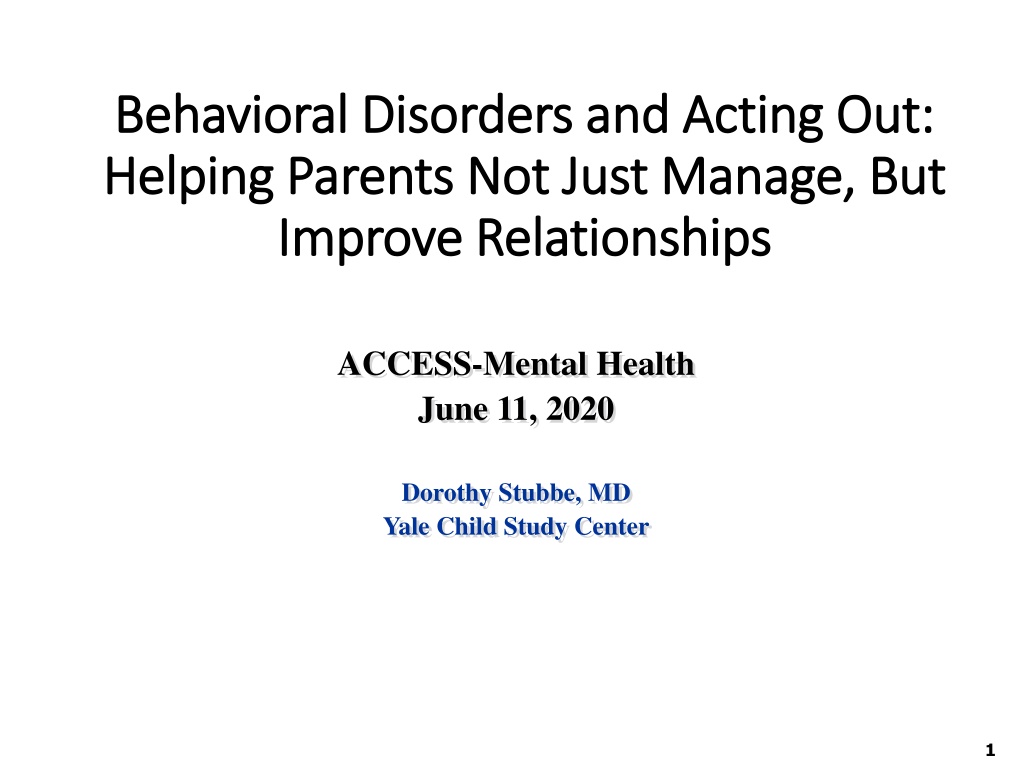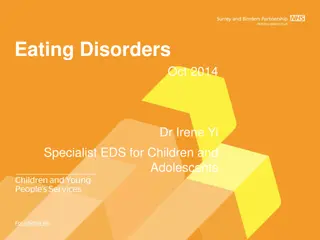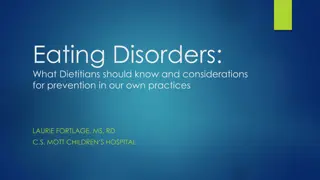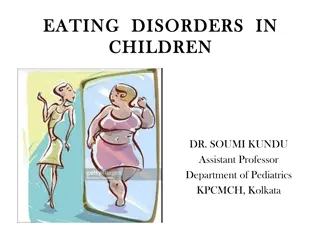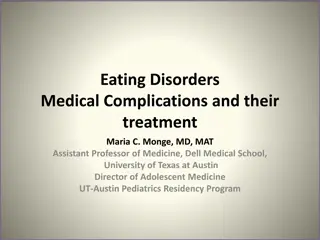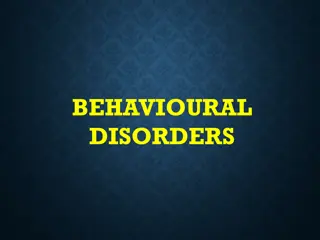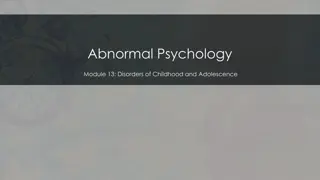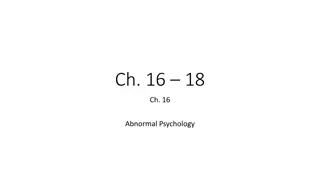Understanding Behavioral Disorders in Children: Strategies for Parents
Explore the complexities of behavioral disorders in children, including Oppositional Defiant Disorder, with a focus on helping parents enhance relationships and implement effective management techniques. Dive into the diagnostic process, treatment approaches, and co-occurring disorders, shedding light on environmental risk factors contributing to disruptive behaviors.
Download Presentation

Please find below an Image/Link to download the presentation.
The content on the website is provided AS IS for your information and personal use only. It may not be sold, licensed, or shared on other websites without obtaining consent from the author. Download presentation by click this link. If you encounter any issues during the download, it is possible that the publisher has removed the file from their server.
E N D
Presentation Transcript
Behavioral Disorders and Acting Out: Behavioral Disorders and Acting Out: Helping Parents Not Just Manage, But Helping Parents Not Just Manage, But Improve Relationships Improve Relationships ACCESS-Mental Health June 11, 2020 Dorothy Stubbe, MD Yale Child Study Center 1
2 Participantswill discuss: The diagnostic workup and differential diagnosis of disruptive behaviors in youth The dynamics of diagnosis and racial disparities in diagnosis and treatment of children and youth with disruptive behavior Engagement and evidence-based treatment of children and their families struggling with acting-out behaviors
Purpose of Aggression Evolutionary protection Secondary to Fear Threat Obstacles Pain To exert dominance To express anger 3
Oppositional Defiant Disorder Oppositional Defiant Disorder act like REAL BADS Resentful Easily Annoyed Argues with adults Loses temper Blames other for his/her misbehavior Annoys people deliberately Defies rules or requests Spiteful 4
Epidemiology: Between 10-20% of children suffer from a behavioral or emotional disorder; Between 1% and 16% of children and adolescents meet criteria for Oppositional Defiant Disorder. More common in boys than girls for younger children and more equal in older children/ adolescents. 5
Co-occurring Disorders ADHD Anxiety Disorders Mood Disorders (Depression, DMDD, Bipolar) Learning Disorders Language Disorders Autism Spectrum Disorders 7
Environmental Risk Factors Environmental Risk Factors High maternal stress in pregnancy In-utero substance exposure Short Derek. (n.d.). Adverse childhood experiences. Retrieved from http://slideplayer.com/slide/9351033/ 8
Environmental Risk Factors Environmental Risk Factors Insecure attachment Child abuse Neglect Harsh and/or rejecting parenting 9
Environmental Risk Factors Poverty High stress Low familial social support Chaos in the home 1 0
Social Risk Factors Social Learning Theory Home - DV, aggressive caregivers Community - violent neighborhoods School - unsafe environments Recreation - violent video games, tv 1 1
Social Risk Factors Social exclusion/rejection Bullying Social humiliation Access to weapons 1 2
Individual Risk Factors Low IQ Developmental delay Difficult temperament Brain injury Previous aggression Family history of antisocial behavior Substance use Psychological problems 1 3
Protective Factors High IQ Secure attachment Adaptive coping skills High frustration tolerance 1 4
1 5 Protective Factors School investment Popularity Positive peer groups Environment where aggression not rewarded Supportive and positive academic environment Church/religious involvement Authoritative Parenting
Warning signs Intense anger Frequent loss of temper or blow-ups Extreme irritability Extreme impulsiveness 16
Prevention Positive school climate Student engagement Increasing coping skills, resilience and emotional intelligence Engage parents/guardians Clear, authoritative disciplinary practices 18
Early Detection Early Detection Screening (examples) NICHQ Vanderbilt Rating Scales SNAP Evaluate for Co-Occurring Disorders, Stresses, and Trauma Children of color are more likely to be diagnosed with ODD and Conduct Disorder than white peers White peers are more likely to be diagnosed with ADHD and Learning Disorders are more likely to be assessed 20
NICHQ Vanderbilt Rating Scale 19. Argues with adults 0 1 2 3 20. Loses temper 0 1 2 3 21. Actively defies or refuses to go along with adults requests or rules 0 1 2 3 22. Deliberately annoys people 0 1 2 3 23. Blames others for his or her mistakes or misbehaviors Is touchy or easily annoyed by others 0 1 2 3 25. Is angry or resentful 0 1 2 3 26. Is spiteful and wants to get even 0 1 2 3 27. Bullies, threatens, or intimidates others 0 1 2 3 28. Starts physical fights 0 1 2 3 29. Lies to get out of trouble or to avoid obligations (ie, cons others) 0 1 2 3 30. Is truant from school (skips school) without permission 0 1 2 3 31. 31. Is physically cruel to people 0 1 2 3 32. Has stolen things that have value 21
NICHQ Vanderbilt Rating Scale 31. Is physically cruel to people 0 1 2 3 32. Has stolen things that have value 0 1 2 3 33. Deliberately destroys others property 34. Has used a weapon that can cause serious harm (bat, knife, brick, gun) 0 1 2 3 35. Is physically cruel to animals 0 1 2 3 36. Has deliberately set fires to cause damage 0 1 2 3 37. Has broken into someone else s home, business, or car 38. Has stayed out at night without permission 0 1 2 3 39. Has run away from home overnight 0 1 2 3 40. Has forced someone into sexual activity 0 1 2 3 4 22
Crisis Intervention Crisis Intervention Calming period Calling 211 (mobile crisis); 911 (ambulance); guardian to pick up Discipline vs. specialized services Behavior plans for unsafe behaviors Assessing threat Engaging the difficult to engage youth 23
Treatment Treatment Parent Management Training Collaborative Problem-Solving (Ross Greene) Anger Control Therapy Multisystemic Therapy Treat Co-Occurring Disorders 24
Parent Management Training: Operant Conditioning Positive Reinforcement: Presentation or of an event after a response that increases the likelihood or probability of that response Negative Reinforcement: Removal of an event after a response that increases the likelihood or probability of that response Punishment Presentation or removal of an event after a response that decreases the likelihood or probability of that response Extinction No longer presenting a reinforcing event after a response that decreases the likelihood or probability of the previously reinforced response Stimulus control: Reinforcing the response in the presence of one stimulus but not in and discrimination the presence of another. This procedure increases the likelihood or probability of the response in the presence of the former stimulus and decreases the likelihood or probability of the response in the presence of the latter stimulus 25
References eAACAP Oppositional Defiant Disorder https://www.aacap.org/App_Themes/AACAP/docs/r esource_centers/odd/odd_resource_center_odd_gui de.pdf Parent Management Training https://depts.washington.edu/hcsats/PDF/TF- %20CBT/pages/positive_parenting.html
References Dubow, E. F., Huesmann, L. R., Boxer, P., & Smith, C. (2016). Childhood and Adolescent Risk and Protective Factors for Violence in Adulthood. Journal of Criminal Justice, 45, 26 31. Herrera, Veronica & Mccloskey, Laura. (2003). Sexual Abuse, Family Violence, and Female Delinquency: Findings From a Longitudinal Study. Violence and Victims. 18. 319-34. Litrownik, A. J., Newton, R., Hunter, W. M., English, D., & Everson, M. D. (2003). Exposure to family violence in young at-risk children: A longitudinal look at the effects of victimization and witnessed physical and psychological aggression. Journal of Family Violence, 18(1), 59-73. Liu, Jianghong & Lewis, Gary & Evans, Lois. (2012). Understanding Aggressive Behavior Across the Life Span. Journal of Psychiatric and Mental Health Nursing. 20. 10.1111/j.1365-2850.2012.01902.x. Moylan, C. A., Herrenkohl, T. I., Sousa, C., Tajima, E. A., Herrenkohl, R. C., & Russo, M. J. (2010). The Effects of Child Abuse and Exposure to Domestic Violence on Adolescent Internalizing and Externalizing Behavior Problems. Journal of Family Violence, 25(1), 53 63. 2 8
